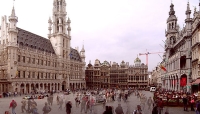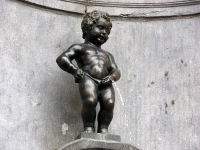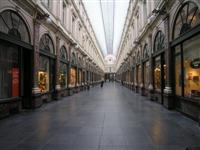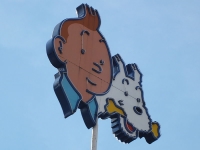Things to do in Brussels
Brussels is packed tight with historic buildings, monuments and museums that constitute a seemingly endless list of worthwhile attractions. The best way to sightsee in Brussels is to pick several personal niche interests and follow a tourist map accordingly. Comic book fans and chocolate connoisseurs, for instance, will find institutions that cater exclusively to their interests among the city's roughly 75 museums, which alternate between explaining Belgium's long history, showcasing its art and architecture, and just plain fun.
Of course, the city has several landmarks that can't be passed up, the most important of which is a visit to Manneken-Pis: the famous centuries-old statue of a boy peeing. After this rather irreverent and quirky highlight, visitors should make for Brussels's larger tourist attractions, most of which are within walking distance of what is considered the heart of Brussels, the Grand Place.
The 600-year-old Hotel de Ville is Brussels's best example of early architecture and is almost as grand a sight as the Royal Palace. Several of the world's best museums are within the city limits, including the Museum of Ancient Art and the Museum of Modern Art, both housing Brussels's best art treasures. Otherwise, the plan should be to relax, enjoy and take it all in between pints of the city's best export, Belgium beer.

Grand Place (Central Square)
The Grand Place is the beating heart of Brussels and has been since the Middle Ages. One of Europe's more beautiful squares, it lies at the centre of a maze of small cobbled street…
Grand Place (Central Square)
The Grand Place is the beating heart of Brussels and has been since the Middle Ages. One of Europe's more beautiful squares, it lies at the centre of a maze of small cobbled streets and is surrounded by richly decorated 17th century Baroque Guildhouses, various Neo-Gothic buildings and museums. But it is the town hall, a magnificent Gothic building, that dominates the square. Markets, flower stalls, and various events are held here and this is the place to get to grips with the essence of Brussels, perhaps over a local delicacy at a pavement cafe.
Website www.brussels.be/grand-place-brussels

Manneken-Pis
This distinctive statue of a naked boy urinating is thought to represent Brussels's irreverent spirit. History has many tales about its beginnings, with one especially whimsical st…
Manneken-Pis
This distinctive statue of a naked boy urinating is thought to represent Brussels's irreverent spirit. History has many tales about its beginnings, with one especially whimsical story having a witch curse a boy to pee for eternity after seeing him tinkle on her front door. The local tradition is to dress the tiny bronze statue at special occasions, and his wardrobe contains more than 800 costumes. The most expensive of them was a gift from Louis XV of France, though the statue has some modern outfits, too, such as a Mickey Mouse costume. As the cheeky fountain is one of the most popular attractions in Brussels, visitors can expect large crowds at most times of day, particularly during tourist season.
Website www.brussels.info/peeing-boy
Hotel de Ville
Brussels's town hall is rated as one of the most splendid civic buildings in Europe. The foundations were laid in 1402 and survived the bombing during World War II when most of the…
Hotel de Ville
Brussels's town hall is rated as one of the most splendid civic buildings in Europe. The foundations were laid in 1402 and survived the bombing during World War II when most of the other buildings on the Grand Place were destroyed. The facade is embellished with gargoyles and images of nobility, while atop the intricate 100 metre-high tower stands a fine statue of St Michael, patron saint of Brussels. Guided tours are available for a small fee and are well worth it to see the fine tapestries and miscellaneous works of art inside.

Galeries Royales Saint Hubert
Mall lovers everywhere should make a pilgrimage to the Galeries Royales Saint Hubert, the very first shopping arcade in Europe. Opened in 1847, the arcade became a drawcard for the…
Galeries Royales Saint Hubert
Mall lovers everywhere should make a pilgrimage to the Galeries Royales Saint Hubert, the very first shopping arcade in Europe. Opened in 1847, the arcade became a drawcard for the elite of 19th century society and today continues to inspire shoppers and browsers alike. People from across the globe, young and old, enjoy perusing here and everyone will find something to their taste.
The architectural marvel has arcaded shop fronts across two floors that are separated by pilasters, conceived in the Cinquecento style of the 16th century Italian Renaissance. The roof above is made of arched glass panes, connected by a delicate cast-iron framework. Visitors will find cafes, restaurants, a theatre and a cinema between the various shops. With so much to see and do here, this attraction is family friendly and one the kids will enjoy too.
Website www.grsh.be/en
Palais Royal
Belgium's magnificent Royal Palace was finished in the 19th century and is the official residence of the Belgian Royal family. Today, the king and his family live at the Royal Pala…
Palais Royal
Belgium's magnificent Royal Palace was finished in the 19th century and is the official residence of the Belgian Royal family. Today, the king and his family live at the Royal Palace of Laeken on the outskirts of Brussels, with the city-based property hosting official functions and serving other ceremonial purposes. The palace is positioned in front of Brussels Park (itself well worth exploring) and directly opposite the modern Parliament building, as if symbolically representing the country's system of government: a constitutional monarchy. Tours are only possible in summer and commence after the National Holiday on 21 July. Inside are a multitude of historical artefacts and some impressive contemporary art, commissioned by Queen Paola of Belgium in 2002.
Website www.monarchie.be
Royal Museums of Fine Arts
Unmissable for art lovers, the Royal Museums of Fine Arts are Brussels's premier art museums and comprise the Musée Old Masters Museum, Musee Modern Museum, Musee Wiertz Museum, M…
Royal Museums of Fine Arts
Unmissable for art lovers, the Royal Museums of Fine Arts are Brussels's premier art museums and comprise the Musée Old Masters Museum, Musee Modern Museum, Musee Wiertz Museum, Musee Meunier Museum, Musee Magritte Museum and the new Musee Fin-de-Siecle Museum. The largest of them is the Old Masters Museum. Opened in 1887, it features the best collection of Flemish art in the world, with highlights including works by Van Dyck and over 20 paintings by Rubens. The Museum of Modern Art was opened in 1984 and includes fine examples from Belgium's best artists over the past century, plus modern legends such as Francis Bacon. The Magritte Museum is devoted to works of famous Belgian Surrealist Rene Magritte, and houses more than 200 of his works, while the new Musee Fin-de-Siecle Museum is dedicated to the 1900s when Brussels was the capital of Art Nouveau.
Website www.fine-arts-museum.be

Belgian Centre of Comic Strip Art
Belgium's love of wacky humour and comic book art come together in this wonderful museum, housed in a fabulous Art Nouveau building designed by one of the pioneers of modern Belgiu…
Belgian Centre of Comic Strip Art
Belgium's love of wacky humour and comic book art come together in this wonderful museum, housed in a fabulous Art Nouveau building designed by one of the pioneers of modern Belgium architecture, Victor Horta. Permanent exhibitions detail the history of European comic strips, while ever-changing temporary exhibitions focus on specific artists, time periods and political contexts. Visitors can see plenty of its most famous subject, Herge's Tintin, as well as the Smurfs and art from over 670 cartoonists. As cartooning is now considered an art form worthy of serious consideration, the museum aims to trace the history and development of the discipline rather than simply to entertain. Guided tours are available for larger groups.
Website www.comicscenter.net/en/home
Royal Museum of Central Africa
Under the direction of King Leopold, the Belgian Congo sent fantastic riches to Belgium in the 19th century, yet the people of that colony paid a terrible price. This museum was fo…
Royal Museum of Central Africa
Under the direction of King Leopold, the Belgian Congo sent fantastic riches to Belgium in the 19th century, yet the people of that colony paid a terrible price. This museum was founded to explore the relationship between European colonial powers and the people they subjugated during the difficult colonial period. Today, it immerses visitors in the very diverse nature of the African continent and its cultural riches, and looks toward a lasting relationship between Africa and Europe. The museum is situated on beautiful grounds in the Flemish commune of Tervuren, just outside of Brussels.
Website www.africamuseum.be



